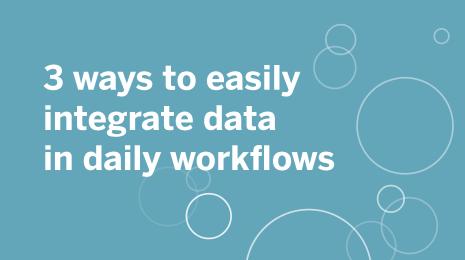How to create a data leadership committee and get everyone on the same page
Editor's note: This article originally appeared in Forbes.
Before we get started, why do I even need one?
It’s now rare to find an executive who doesn't want their organization to be more data driven. Becoming a data-leading company requires not only data and analytics but also a data culture—a way of working that puts data at the heart of every decision. In companies with a data culture, everyone, regardless of their role, can find insights to improve the business.
At many organizations, these cultures begin to take root upon the formation of a data leadership committee, a permanent group of appointed stakeholders whose mission is to drive value with data. You might be familiar with other terms for teams that share this core mission, including data champions group, data steering committee, and data council. No matter the name, the mandate is the same: to ensure that decisions are based on data and that results are visible to the entire organization.
Where we've seen organizations be successful is when they not only focus on building the skills, but when they get people excited about data.
Data leadership committees are particularly adept at accomplishing these five goals:
1. Pairing data and expertise with meaningful business challenges.
There’s often debate within organizations about which challenges are biggest or most important, leading them to use data and resources in a random and uneven fashion. By dedicating time, attention, and resources to data projects that drive the most value, companies can solve the most complex challenges—the kinds of problems that keep executives up at night.
2. Focusing the business on a short list of data-driven metrics.
Most organizations don’t lack data, but many have difficulty building a consensus around what the data means. This can lead to internal debates about definitions and different versions of similar metrics. By standardizing data definitions, peers with different responsibilities can work collectively toward the same data-driven goals.
3. Promoting continuity and consistency in data strategy.
Using data well, and consistently across all organizational levels, is much harder than tallying up quick wins. A committee helps ensure ongoing progress and that incremental wins benefit multiple teams, not just one.
4. Connecting data to organizational health.
Without focus or coordination, data-driven efforts can put too much emphasis on quarterly financial figures or narrow department-level goals with little impact on the big picture. A committee encourages the organization to look at a wide range of goals and challenges and makes it known when results can be realized.
5. Guiding the entire organization toward a data culture.
To build a culture where everyone embraces data use, employees need to consistently hear the message that using data is important. When executives and key leaders demonstrate data-driven behavior and articulate the impact of data within their teams, expectations about the role data can play throughout the organization are reset.
That sounds great, but who should get a seat?
A data leadership committee should comprise senior leaders across business lines and departments—people who are invested in and responsible for improving business outcomes—and be led by an executive with passion for data. Members must include:
Executive sponsor
The committee champion should already report to the CEO and have experience navigating competing business priorities, advocating for large-scale transformation, and playing a decisive role in the company’s biggest day-to-day decisions.
Members of the C-suite who oversee information, data, and technology are common sponsors, though some organizations choose chief financial officers when objectives are centered on financial metrics. Ideally, the sponsor knows how the executive team thinks about data and how to better integrate analytics into their meetings and decision making.
Data experts
While often chief data officers, information officers, or technology officers, data experts do not always have a formal leadership role over data. They show up with passion beyond their specific focus area to champion data across the organization.
They also contribute recommendations about data quality, data consolidation, and data analysis so there’s a single version of the truth that makes consumption faster and easier. Data experts are often at the forefront of executing the organization’s data strategy and can identify investments that are needed to be successful.
Business experts
These non-technical leaders, sometimes members of the executive team like chief marketing or chief operating officers, add critical relevance and purpose to committee efforts by leveraging their industry experience and desire to improve the business.
They provide important context for what the data represents—whether that’s customer engagement, revenue, or employee retention. By participating, they often change the minds of skeptics and set an example for others. “This population often isn’t included, but business leaders are really important,” said Ashley Howard Neville, senior evangelist at Tableau. “They speak to the on-the-ground situation.”
How can I start and manage a data leadership committee?
Data leadership committees bridge the gap between vision and execution, refining how everyone engages with data.
“When the organization sees its leaders using data, it’s more likely that people will be receptive to also integrating data into their work.” - Ashley Howard Neville, Senior Evangelist, Tableau
Here’s how to start and evolve a committee in five steps:
1. Identify high-value business goals.
Think big targets, not low-hanging fruit. “If resources were unlimited, if you had all the data you wanted, what would you try to tackle first? That’s what you should find a way to go after,” Neville said.
2. Agree on metrics to measure progress.
Consider how the efforts of different teams contribute toward the organization’s goals, and then identify which metrics will help leaders from a range of departments forecast their contributions. Effective metrics are leading indicators of outcomes, such as how deal size affects revenue gain.
3. Communicate the benchmarks.
Once you know how your organization is performing, it’s critical to articulate how you expect the business to perform in the future. Outline how success will be measured and who is responsible for driving and meeting each benchmark. There may be multiple owners who contribute materially to each goal.
4. Establish a data reference guide.
For example, sales and marketing may use different definitions when referring to seemingly simple concepts, such as “new customer.” The committee must understand when and how these kinds of differences occur and help translate so everyone ties back to a single source of truth in repeatable, consistent ways.
5. Make data easily accessible and understandable.
Build both clarity and trust into your data-driven efforts by making committee-level insights available to all. Dashboards are a good start. Interactive and visual reporting tools that answer deeper business questions can help a bigger audience ask questions of data.
How will I know my committee is successful?
A data leadership committee doesn’t just set benchmarks for everyone else. It should also hold itself accountable. Here are three questions that executives should ask to gauge committee success:
1. Does the committee align different groups across the organization around data?
It’s okay if groups diverge in conversations about the most important data or the right way to apply it. It’s not okay if cross-functional discussions are impossible because those disconnects become insurmountable.
2. Has the committee made tough choices about data investments?
Knowing when to shut down a project or reassign investments is just as important as starting new initiatives. “When you understand even one or two areas where you’re creating value, you can better justify all the investments you are making to improve analytics,” Neville said.
3. Does the committee measure results and report findings?
The organization should hear from its leaders, loud and clear, about how using data has improved business performance. The committee should speak about customer and market-driven metrics, such as satisfaction and market share, as well as internal, employee-driven metrics like engagement and hiring trends.
Are you ready to get started?
When business leaders discuss creating a data leadership committee, they should identify business value that can be maximized through better use of data analytics. Organizations that use this approach tend to be more successful than those focused on why data is failing to maximize business value.
When data leadership committees are given full executive support, they have the power to transform the values and beliefs that underlie how data is used. This sets a solid foundation on which a data-driven organization is built.
For more information about how leaders can and are supporting a data culture to create business value, read the following Tableau posts:
Related Stories
Subscribe to our blog
Get the latest Tableau updates in your inbox.






